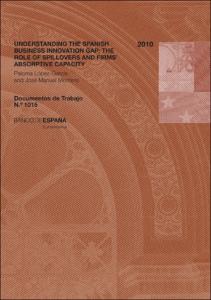Registro completo de metadatos
| Campo DC | Valor |
|---|---|
| dc.contributor.author | López García, Paloma |
| dc.contributor.author | Montero, José Manuel |
| dc.coverage.spatial | España |
| dc.date.accessioned | 2019-08-10T17:57:22Z |
| dc.date.available | 2019-08-10T17:57:22Z |
| dc.date.issued | 2010-06-28 |
| dc.identifier.issn | ISSN: 0213-2710 (en papel) |
| dc.identifier.issn | ISSN: 1579-8666 (en línea) |
| dc.identifier.uri | https://repositorio.bde.es/handle/123456789/7033 |
| dc.description.abstract | This paper investigates whether the existence of knowledge spillovers, differences in the capacity of firms to assimilate them and disparities in some human resource management practices are related with the decision to innovate of Spanish firms. In order to do this, we employ data from the "Central de Balances" database, which covers both manufacturing and services firms during the period 2003-2007, and use an estimator proposed by Wooldridge (2005) for dynamic random effects discrete choice models. The empirical exercise provides evidence on the positive link between spillovers and the innovative behaviour of companies, not just for the knowledge generated in the same industry, but also for that generated in the same region or by the public sector. Moreover, this link is stronger for those firms with a higher capacity to absorb those spillovers. This ability not only works through firms’ R&D capabilities, but also through such factors as the quality of the labour force, the share of temporary employment and the amount of resources spent in training. In addition to these factors, we find that innovation performance exhibits a high degree of inertia. Further, some other observed firm characteristics, such as size, sales growth, export behaviour, sector capital intensity or financial structure variables, are also found to be relevant determinants of the likelihood of innovation |
| dc.format.extent | 49 p. : tab., gráf. |
| dc.language.iso | en |
| dc.publisher | Banco de España |
| dc.relation.ispartof | Documentos de Trabajo / Banco de España, 1015 |
| dc.rights | Reconocimiento-NoComercial-CompartirIgual 4.0 Internacional (CC BY-NC-SA 4.0) |
| dc.rights | In Copyright - Non Commercial Use Permitted |
| dc.rights.uri | https://creativecommons.org/licenses/by-nc-sa/4.0/deed.es_ES |
| dc.rights.uri | http://rightsstatements.org/vocab/InC-NC/1.0/ |
| dc.subject | Innovation |
| dc.subject | R&D |
| dc.subject | Spillovers |
| dc.subject | Absorptive capacity |
| dc.subject | Skilled labour |
| dc.subject | Temporary employment |
| dc.subject | Dynamic RE probit model |
| dc.title | Understanding the Spanish business innovation gap : the role of spillovers and firms' absorptive capacity |
| dc.type | Documento de trabajo |
| dc.identifier.bdebib | 000275995 |
| dc.identifier.bdepub | DTRA-201015-eng |
| dc.subject.bde | Política industrial |
| dc.subject.bde | Financiación de la empresa |
| dc.publisher.bde | Madrid : Banco de España, 2010 |
| dc.subject.jel | O32 |
| dc.subject.jel | C23 |
| dc.subject.jel | C25 |
| dc.subject.jel | J6 |
| dc.subject.jel | J24 |
| dc.subject.jel | L00 |












